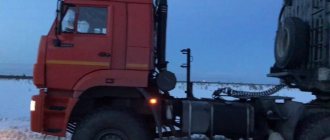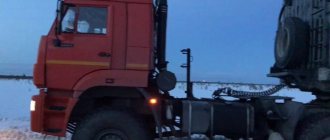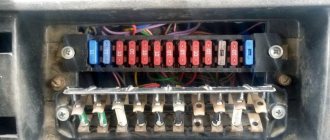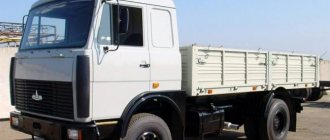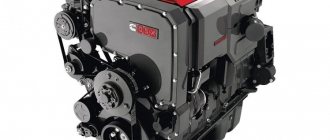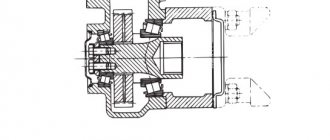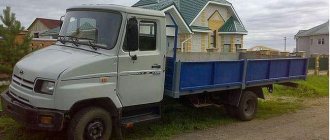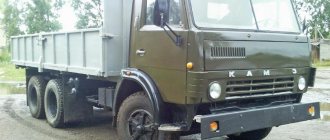Welcome to the page of our website. The KAMAZ truck is a mass-produced vehicle and sometimes breaks down. There is a very unpleasant situation when the engine does not gain speed when you press the gas pedal. At the same time, the check engine malfunction lamp lights up on the instrument panel. But there are exceptions when the error indicator does not light up. There can be many reasons when a car does not pick up speed: starting from a malfunction of the fuel system, a malfunction of the engine control unit, shorted/broken electrical wiring harnesses and many other reasons. Our company’s specialists have accumulated extensive experience in diagnosing and repairing the described malfunctions. After the diagnostics are carried out, faulty parts and equipment are identified and repairs are carried out followed by replacement if necessary:
- Details
- Sensors
- Wiring harnesses
- Electronic units
- Other equipment
Electronic control systems KAMAZ
Recently, engines from the Kama Automobile Plant began to be classified according to their belonging to one or another environmental class (from Euro-0 to Euro-4). The technical implementation of the Euro-3 class, and then Euro-4, adopted in 2013, turned out to be impossible without the use of electronic engine control systems (ECM). This is what led to the opportunity to perform self-diagnosis of the car using KAMAZ universal error codes.
Ecological class Euro-4
Various configurations of KAMAZ trucks began to be equipped with engines with electronic control units (ECU). And if now the driver is concerned about unhealthy behavior during the operation of famous trucks, symptoms appear in the form of floating speed, loss of traction, unusual noises, increased diesel fuel consumption, self-diagnosis comes to the rescue.
Using information output from the ECU in the form of an error code, it is possible to indicate an accurate electrical diagnosis for KAMAZ. The process of diagnosing and deciphering codes depends on the type of electronic system installed on the truck. Before starting diagnostics, it is suggested to determine the type of ECU based on the installed engine model.
Engine Model Table
Self-Diagnostics No matter what company your V8 is made by, Cummins Inc. (Cummins) or KAMAZ LLC, it is equipped with fuel supply systems from Common Rail and exhaust gas recirculation (EGR) or neutralization systems (SCR), diagnostics will be carried out in accordance with these two types.
The process of self-diagnosis of KAMAZ electronic systems in Euro-3, -4 engines differs slightly from a similar procedure in other vehicles. After pressing a certain button, one of the lamps on the dashboard or indicator unit will begin to blink at different intervals; the number of flashes of the lamp at one interval determines the digit of the code.
Engine with ECU BOSCH MS 6.1
So, let’s get comfortable in the cabin of our KAMAZ, then turn on the ignition with the usual turn of the key. Along with many other indicators, the diagnostic indicator light or “Check Engine”, or in common parlance, a submarine, lights up. The lamp lights up for 3 seconds and goes out, thereby demonstrating its functionality and the serviceability of the ECM. If the lamp does not go out or lights up while the engine is running, a malfunction has been found in the electronic system!
Diagnostic indicator lamp
Let's pay attention to the diagnostic mode rocker button (often mounted on the instrument panel on the left, under the steering wheel) or the button for this mode (often located next to the fuse box, under the panel opposite the passenger seat). The “rocker” has two extreme positions for holding and a central fixed position.
Lower the rocker to its highest or lowest position and hold it there for more than two seconds. Just press the button and do not release it for the above-mentioned time. After the rocker or button returns back, the diagnostic lamp will flash first in long intervals and then in short ones. The number of long flashes determines the first digit of the error code, the number of short flashes determines the second digit.
Blink Code Alarm Diagram
The diagram shows an example of obtaining code 24. We compare the error code (otherwise blink code, from the English blink - blink) with the table below.
| Error codes for the BOSCH MS6.1 ECU of Euro-3 eco-class engines | ||
| Error code | Description of the malfunction | Operating restrictions set by the ECU |
| 11 | gas pedal | engine speed is limited to 1900 rpm |
| 12, 13 | atmospheric pressure sensor | not limited |
| 14 | clutch sensor | engine speed is limited to 1900 rpm |
| 15 | crankshaft rotation frequency sensor | engine speed is limited to 1600 rpm |
| 16, 17 | Incorrect polarity of frequency rotation sensors; sensors are not installed correctly | engine speed is limited to 1800 rpm |
| 18 | frequency camshaft rotation sensor | engine speed is limited to 1800 rpm |
| 19 | main relay | not limited |
| 21, 22, 24—26 | high pressure fuel pump | engine start failure |
| 23 | inappropriate position of the gas and brake pedals | not limited |
| 27 | poor contact of rack position sensor | engine start failure |
| 28 | brake pedal sensor | not limited |
| 29, 51—53, 81—86, 99 | electronic control unit | engine start failure |
| 31, 32 | air temperature sensor | not limited |
| 33, 34 | air pressure sensor | not limited |
| 35 | cruise control module | not limited |
| 36, 37 | liquid cooling temperature sensor | engine speed is limited to 1900 rpm |
| 38, 39 | fuel temperature sensor | engine speed is limited to 1900 rpm |
| 41 | the signal from the multi-stage input does not correspond to the reference | not limited |
| 42 | maximum engine speed exceeded | The wrong gear may have been selected. Resetting the error when starting the engine again |
| 43 | speed signal error | engine speed is limited to 1500 rpm |
| 54 | excess on-board voltage | not limited |
| 55 | The control unit operation cycle is not completed correctly | not limited |
| 61—67 | CAN line | not limited |
KAMAZ engine malfunctions
The main malfunctions of KAMAZ engines and possible solutions to them.
1. Low pressure in the engine
The problem may be wear of the liners, but first we check and clean the oil pump. First, check that the pressure relief valve is not stuck. It has a separate radiator section responsible for cooling the oil. Overheated oil can also cause a drop in pressure. At idle speed when hot, the pressure should not drop below 0.8 with a tachometer reading of 600 rpm. At 2600 rpm, the pressure should be at 3.5 - 4 on the mechanical sensor. If the oil pressure is low, also check the fastening of the oil intake with the pan removed and the presence of a gasket under it.
2. Increased fuel consumption
As the practice of operating KAMAZ trucks shows, this truck consumes 35–40 liters of diesel fuel, despite the striking differences in fuel consumption rates recorded in the passport. When consumption increases, this indicates a clogged oil filter and the need to change the oil. Also, the use of low-quality fuel increases the consumption of diesel fuel. Consumption increases when a trailer is hitched. In the urban cycle it is consumed 7-8% more than on the highway.
3. The motor gets hot
Start rebuilding the cooling system by checking the coolant level and thermostat. Next, the radiator is washed, all pipes and fasteners are inspected. How the temperature sensor works, whether the fan rotates - you will have to check this. The next step is to check the pump. The most unpleasant failure is a rupture of the cylinder block gasket when water or antifreeze gets into the oil. If the fuel system is not configured correctly, the engine may also heat up more than usual.
4. Unstable operation (for example, vibrates, shakes)
Vibrations can appear in certain engine operating modes - cold or hot, at idle or with a set of them. In any case, unstable engine operation indicates a breakdown. The following possible reasons for the unit shaking: - You changed the crankshaft, but did not balance it with the flywheel and clutch basket. This procedure is performed on a special stand. — Invalid cylinder. — It’s time to change the injection valves in the fuel injection pump. — The injectors are acting up, try swapping them. — Bending of the crankshaft, development of intermediate and driven disks.
5. Smokes (a. white smoke, b. black smoke)
White smoke usually appears in the exhaust system of a KAMAZ vehicle when it is started cold at sub-zero ambient air temperatures. In this case, water particles in the fuel turn into steam during combustion. It’s worse if coolant gets into the cylinder through a broken exhaust manifold gasket, cylinder head, or through a crack in the head. In this case, you will have to change the gasket and head. Black smoke indicates improper operation of the fuel system, excess oil entering the combustion chamber, sticking rings, cracks in liners or pistons. Black smoke comes from a clogged air filter.
6. Knock
Knocking occurs when there is oil starvation, when the oil passages become clogged or we are dealing with highly diluted low-quality oil. Often in a knocked engine the crankshaft jams and the bearings on the connecting rods rotate. Thus, there is a loose condition of the crankshaft, a malfunction of the oil pump, or diesel fuel getting into the lubricant. Oil filters may also be clogged, and particles of metal shavings get between the rubbing surfaces, further aggravating engine problems. Due to wear, the camshaft, valves and fingers may knock.
7. Doesn't start
The most common reasons that the engine will not start are water impurities in the fuel and air leaking into the fuel line. In the first case, the separator is checked, the collected water and sediment are drained until no diesel fuel remains in the coarse filter. In case of the second malfunction, check the fixation of all hoses and connections. They must be sealed. The KAMAZ engine may not start due to a clogged air filter or a dirty fuel intake in the tank.
8. Stalls
The situation is similar to the option when the engine does not start. First of all, the oil, filters, impurities in the fuel, the fuel line for leaks, as well as the electrical circuit for connecting the pump are checked. It happens that the fuel pump cuts off the immobilizer, but this is a fairly rare symptom. If there is a problem with the regulator, the car stalls when the gas pedal is suddenly released. If it stalls at idle, it means that the valves in the injection pump may not be holding, or the piston may be hanging.
9. Sapunitis
In an over-produced piston system, the air compressed in the combustion chamber partially leaks between the rings and enters the crankcase, creating excess pressure. As a result, gases escape from the location of the oil dipstick. The problem is solved by overhauling the piston group. However, there are cases when the cylinders and rings are not worn out, but only coking of the rings occurs. Sometimes it is possible to decarbonize the rings using a hard additive and revive the engine.
10. Troit
If the KamAZ engine is running, it produces vibrations and specific noises. At the same time, its unstable operation is noted. The easiest way to determine a breakdown is when one cylinder fails, but when they all work, it is somewhat more difficult to determine the cause of the tripping. It is worth noting that the engine stalls under different conditions, at idle or at high speeds, under load or without load, on a cold engine or after warming up. The main causes of tripping are failure to ignite the fuel in the combustion chamber or incorrect operation of the glow plug or injectors.
11. Does not develop speed
It happens that the engine does not develop power, and works fine in lower gears, for example, from 1st to 3rd, and then seems to suffocate. This usually happens due to air leaks, when in higher gears the mixture is no longer suitable for maintaining power. Look at the settings of the camshaft and valves, or maybe the ignition is set incorrectly. The oil burns in the exhaust manifold, and carbon deposits gradually narrow the diameter of the pipes in the exhaust system. Such constipation also leads to inhibited operation of the power unit.
12. Oil in engine camber
Oil enters the KAMAZ engine camber from under the compressor at the junction of the rear plate with the block. There is an oil channel there and if the gasket ruptures, oil flows out. The oil seal on the injection pump drive bearing or the oil drain pipe from the injection pump may also be leaking. It may also be leaking from under the power steering pump. When you have cleaned the entire block, you can determine the source of the oil leak visually. To do this, the problem areas are wiped dry with a rag, then the car starts and you can see where the leaks are.
13. Increased oil consumption
Oil is consumed in any engine, whether new or after a major overhaul. The difference is normal consumption and excessive. The main reason for oil consumption in a KAMAZ engine is its leakage from under the gaskets and worn out oil seals. The use of low-quality materials leads to softening of the seals and loss of lubricant. When the unit overheats, oil begins to ooze from under the cylinder head gasket. Oil also has its own waste - fuel consumption associated with engine operation. The oil is not completely removed from the cylinder walls by oil scraper rings, and some of it burns out during the operating cycle. Cylinders, rings, exhaust valves wear out over time and increase waste. In these cases, it is necessary to overhaul the engine. It is worth noting that prolonged idling greatly affects oil consumption in the KAMAZ engine.
14. Oil in the cooling system
If the cylinder head gasket is broken along the lubrication line, the oil will mix with the coolant and end up in the expansion tank. The gasket needs to be replaced, or rather, the O-rings of the cylinder liners. Mixing antifreeze or water with oil can occur in any unit that is lubricated and cooled. This could be the compressor or the fluid coupling switch. The latter most often passes fuel and lubricants into antifreeze. The switch has a thermal power sensor, and its leaky rolling is a very possible reason for the appearance of grease in the cooling system.
15. RPM fluctuates
When refueling with low-quality winter diesel fuel, the plunger pairs fail. The plungers do not press enough at low speeds, so they float. Pairs need to be changed. The problem is typical for Euro-3 engines. Perhaps centralization needs to be configured. Need diagnostics. The high pressure pump may be working properly, but the speed is affected by errors in the operation of the control unit, sensors, and the contact may simply come loose. The rack smoothness adjustment is also used.
16. Normal pressure hot and cold, for a new engine or after repair
Standard of normal oil pressure for a warm KAMAZ engine: - at 600 rpm, MPa - 0.1 - at 2200 rpm, MPa - 0.4 - at 2600 rpm, MPa - 0.5 When cold, the pressure is distributed in range 5 – 6 kgf/cm² (0.5 – 0.6 MPa). On the new engine the pressure will be stronger, to the maximum, if all the units are working properly. After capitalization, the pressure on KAMAZ trucks often drops and does not rise above 0.25 MPa.
17. Engine whistling
The turbocharger gives a specific whistle. In this case, carefully inspect the impeller and replace (or carefully check by bending) the pipe. Activation of the mountain brake redistributes the pressure in the system and puts additional load on the turbine shaft. The bearing becomes loose and the impeller begins to touch the turbocharger housing. The second category of whistling parts are drive belts, for example, a radiator fan. And also the wear of the roller bearings creates a similar whistle. You should diagnose all of these elements.
18. Causes of engine overheating
Engine overheating is the most common reason for stopping the unit and sending it for repair. It is necessary to monitor the devices so that the coolant does not heat up more than 100 degrees and boil. However, there are main reasons for overheating: - insufficient coolant level (antifreeze or water) in the cooling system, monitor the level in the expansion tank; — the radiator fins are clogged; — dirt in the cooling system, deposits damage the thermostat.
19. What can cause a piston to crack?
Option one is overflow of injectors, hence increased temperature conditions. Option two – banal overheating of the power unit. Thirdly, when the piston wears out, scuff marks form on its surface, leading to failure of the piston group. Fourthly, the entry of liquid, namely water, into the combustion chamber leads to water hammer in the cylinder, a sharp increase in pressure and destruction of the piston.
Video “Getting Error Codes”
The video shows an example of receiving error codes 36 and 37.
Automotive technology has become a part of everyday life. Today, not a single industry can do without the help of transport. In terms of freight and passenger transportation, the products of the Kama Plant (KAMAZ) occupy a leading position in the market. Despite the reliability and quality, owners are faced with the fact that the KamAZ engine does not work.
This is a common phenomenon because there are many reasons for it. You need to start with a banal discrepancy between the fuel and the required quality, and end with a breakdown of the power plant, requiring prompt intervention. Let's try to figure out why KamAZ doesn't work, what are the prerequisites and solutions to the problem.
Characteristic signs and causes
Faced with a problem of this kind, the user tries to figure out why the KamAZ truck does not work and the reasons for this behavior of the equipment. This is connected with the power plant, so the search for a solution takes place in this plane.
As a rule, the first steps are to diagnose the power plant. This approach saves search time and also indicates the nature of the breakdown.
KamAZ, “floating” engine speed:
A harmless reason is the lack of traction on the new KamAZ vehicle. This is due to the running-in of the vehicle - grinding in parts and mechanisms to each other. This behavior is considered normal and disappears when the car travels 5,000-10,000 kilometers.
Severe wear of engine parts
This problem is an unpleasant reason for the owner of a KamAZ car. As a rule, the behavior is typical for old cars that are used intensively. The problem also manifests itself on new equipment that was used in harsh conditions in violation of standards.
KamAZ engine, severe wear of parts:
The rings and cylinders of the power plant are subject to wear, as loaded engine parts. The first sign, a drop in compression, is checked first. For a KamAZ diesel engine, the compression indicator is at least 20 kg*cm2. If the compression is lower, the unit is repaired.
Sometimes it is necessary to clean the cylinder head and valves from accumulated coke. To do this, the head is dismantled and the procedure for cleaning and lapping the valves is carried out.
Cummins ISBe diesel overheating
When the engine overheats, the volumetric air flow decreases and the fuel ignites earlier than the specified time.
As a result, the power developed by the engine decreases. Signs of unstable operation that accompany engine overheating: unstable operation, strong vibrations and knocking, dense exhaust smoke.
Overheating can be caused by incorrect adjustment or a number of malfunctions of diesel engine components and assemblies.
In order to determine the cause, it is necessary to check:
- condition of radiator hoses,
- thermometer status,
- engine cleanliness, presence of leaks,
- oil and coolant levels,
- condition of the radiator (if clogs with rust or scale are detected, it is necessary to flush the radiator and cooling system),
- condition of the fan blades and the electromagnetic fan clutch (if provided),
- condition of drive belts and their tension,
- exhaust gases entering the cooling system (this is a consequence of damaged cylinder head gaskets). It is necessary to remove the radiator cap and check for bubbles in the fluid at idle speed. The pH of the liquid is measured - if exhaust gases enter the cooling system, it increases.
In the case of high exhaust smoke density, the injection system is the cause of engine overheating. In this case, you need to check the fuel injection timing adjustment.
Filter elements
There is a situation when the KamAZ 3110 does not pull uphill, the reason for this lies in the lack of fuel entering the engine combustion chamber. Another characteristic feature is that the car twitches, the power plant does not work confidently.
A common cause is a clogged filter element. As a rule, a KamAZ vehicle is equipped with two fuel filters - coarse and fine. The coarse filter is installed in conjunction with the fuel pump, or is inserted into the fuel supply. A thin filter is located directly in front of the injectors. If one filter element does not perform its function, the engine does not have enough fuel. As a result, the motor does not use its full potential.
KamAZ, fuel filter:
In addition, the purity of the air supplied to the cylinder is important for mixture formation. The air filter element is responsible for this indicator. Often, the air filter becomes clogged in the summer, when the car is used in conditions with high dust concentrations. Dirty air does not allow the working mixture to fully burn, as a result, power is lost, the unit does not pull, and fuel residues are deposited in the form of deposits inside. To avoid these troubles, filter elements are changed as needed.
Glow plugs
The glow plug, located in the combustion chamber, is an integral element of a modern diesel engine. The part helps to ignite the fuel charge and makes the combustion intense. Considering the fine-tuning of modern engines, a malfunctioning spark plug leads to a loss of unit power, and at temperatures of +5° and below, it becomes difficult to start the engine.
KamAZ, glow plug:
To avoid troubles, monitor the instrument panel readings: a non-working glow plug indicator is the first sign of a problem. In addition, if the indicator burns longer than expected, it indicates a malfunction of the thermal switch or temperature sensor.
Carrying out diagnostics of glow plugs will help to avoid problems with loss of power.
Exhaust
In pursuit of environmental standards and compliance with Euro standards, modern internal combustion engines are equipped with catalysts, afterburning mechanisms, and probes. Therefore, moments when KamAZ, which meets Euro 4 standards, does not meet the requirements, occur frequently. The point is the catalyst, the inside of which contains a special composite filter. The filter components further purify the gases. If you use fuel that does not meet the established standards, the filter quickly becomes clogged and fails. Sensors automatically reduce the speed of the power plant, as a result, the car produces insufficient power. To fix the problem, the part is changed.
If you find any problems with the KAMAZ engine, you should pay attention to the operation of the power system. During a more detailed inspection, diagnostics of fuel equipment is carried out, guided by the standards and operating recommendations specified in the technical characteristics of the KAMAZ injection pump.
Symptoms of malfunction of fuel injection pump KAMAZ 740, fuel injection pump KAMAZ 4310
Malfunctions of fuel pumps and regulators manifest themselves in a violation of adjustment due to wear of parts, which results in the occurrence of extraneous noise, overheating and fuel leakage.
The main reason for the malfunction of the fuel pump is wear of its parts, weakening of the tightness in the fits, increased gaps in the moving joints, violation of the location of the parts, and deposits on the surface of the parts in the form of dirt and carbon deposits.
The consequence of pump malfunctions can be a decrease in the supply of fuel in the required quantity and uneven supply. Failure to properly supply fuel is usually caused by wear of plunger pairs, pump discharge valves, plunger drivers, rack clamps, rack teeth and bushing gears, and clogging of injectors. Such malfunctions lead to a decrease in engine power and efficiency.
Uneven supply of fuel to the engine cylinders will lead not only to unstable operation at low speeds, but also to interruptions in the operation of individual cylinders, which will be accompanied by vibration of the engine block.
Fuel injection pump malfunctions include uneven start of injection and delay in injection timing of a multi-section pump, which occurs due to wear of the pusher adjusting bolt, roller axis, pusher and roller housing, ball bearings, as well as wear of the cam shaft.
Wear of plunger pairs and injection valves significantly affects the change in the fuel injection advance angle.
Knocks and noises from a Cummins diesel engine
Determining the causes of increased engine noise and knocking can be a rather complex and lengthy process.
It is not always clear which particular component of a complex engine mechanism is failing. But if additional signs of certain failures appear - such as instability in the operation of the cylinders, unstable diesel operation, increased smoke - determining the source of unstable operation becomes easier.
The most obvious and common cause of knocking noises is low-quality fuel.
The most difficult failure to diagnose is caused by faulty pistons—broken piston rings or pins—as well as worn tappets or crankshaft bearings. In cases of wear or damage to the main and connecting rod bearings, the source of the noise is also difficult to determine.
Characteristic knocking noises of a diesel engine and their causes:
- A sharp metallic sound at low speeds that disappears as the engine warms up can be produced by a weakened piston pin.
- A dull knock when accelerating a car is produced by worn main bearings.
- A dull knock at idle or under light load, which disappears as the load increases, is produced by worn connecting rod bearings.
- Typically, a damaged piston produces a weaker knocking sound compared to connecting rod bearings. As the diesel engine warms up, the knocking noise disappears.
- Clicking sounds in all engine operating modes are produced when the piston rings or ring pads are damaged.
- Strong low-pitched noise (crackling, rumble) is a consequence of increased clearance in the mesh of the timing gears or loose fit of the gears on the shafts.
- A howling sound is produced by gears with clearance below normal.
If knocking occurs, it is necessary to remove the oil filter and cut off its core. If particles of aluminum, steel or chromium are found in the filter element, the failed part can be identified.
The main reasons why the KAMAZ engine does not start:
- There is no fuel in the fuel tank;
- Presence of air in the fuel system;
- Clogged or contaminated fuel lines of the KAMAZ power supply system;
- The fuel has thickened due to low temperatures;
- Malfunctions of the high pressure fuel pump (injection pump malfunctions)
- Clogged fuel filters.
To determine the malfunction of the power system, you should follow the chain from less expensive and costly faults to more costly ones, taking into account the flow chart for repairing the power system.
KAMAZ is not gaining momentum
Welcome to the page of our website. The KAMAZ truck is a mass-produced vehicle and sometimes breaks down. There is a very unpleasant situation when the engine does not gain speed when you press the gas pedal. At the same time, the check engine malfunction lamp lights up on the instrument panel. But there are exceptions when the error indicator does not light up. There can be many reasons when a car does not pick up speed: starting from a malfunction of the fuel system, a malfunction of the engine control unit, shorted/broken electrical wiring harnesses and many other reasons. Our company’s specialists have accumulated extensive experience in diagnosing and repairing the described malfunctions. After the diagnostics are carried out, faulty parts and equipment are identified and repairs are carried out followed by replacement if necessary:
- Details
- Sensors
- Wiring harnesses
- Electronic units
- Other equipment
The KAMAZ 740 engine does not develop full power
- Replace the air filter;
- Adjust the fuel supply angle;
- Clean the injectors, adjust the injectors;
- Repair the injection pump;
- Check the operation of the KAMAZ injection pump.
Uneven operation of the KAMAZ 740, KAMAZ 4310 can be caused by loss of functionality of individual injectors, a malfunction of the high-pressure fuel pump or its regulator. Damaged injectors must be replaced, and the injection pump, as a more expensive part, is checked on a fuel stand and repaired if necessary.
Repair of KamAZ EMERCOM
One of these cases of diagnosis and repair. The first call of the quiet morning began with an application for a KAMAZ vehicle, which is on the balance sheet of the glorious organization of the Ministry of Emergency Situations of Moscow. KAMAZ had a problem with underdevelopment of engine speed. The car was not new based on its production year. Fuel equipment BOSH, engine ECU of the same brand. The first diagnostics immediately showed damage to the engine harness. I had to spend time working on electrical equipment repairs. Such cars should not break down, especially on trips of the EMCHES members themselves. They treated their work with the utmost responsibility, and it was soon completed.
Good afternoon, such a problem, Shakman Euro 3, it resets to 1500, the service center said that it’s PROBABLY the injection pump, but they’re not sure, I talked to several mechanics, they said that it’s unlikely, if the injection pump flies, then it won’t go at all, I called to call a computer technician for help , he refused to go, he said to switch the brains from another and try, they did it, the problem was not solved, which means the problem is not in the computer. The filters were changed, the injectors were cleaned. Has anyone encountered this problem?
look not for the effect, but for the cause... what happened before?!
Good afternoon, such a problem, Shakman Euro 3, it resets to 1500, the service center said that it’s PROBABLY the injection pump, but they’re not sure, I talked to several mechanics, they said that it’s unlikely, if the injection pump flies, then it won’t go at all, I called to call a computer technician for help , he refused to go, he said to switch the brains from another and try, they did it, the problem was not solved, which means the problem is not in the computer. The filters were changed, the injectors were cleaned. Has anyone encountered this problem?
The same problem, the limit is turned on at 1500, the fuel injection pump is normal, I did the injectors, I myself am also trying to tighten the diagnostician to the object, so I’m waiting until the time appears, it looks like electronics. Moreover, the limitation does not always turn on, but only when you slow down with the engine or the mountain brake.
So, take off the injectors and take them to the stand, probably some kind of diesel fuel is driving
So, take off the injectors and take them to the stand, probably some kind of diesel fuel is driving
checked, all injectors work as expected.
So, take off the injectors and take them to the stand, probably some kind of diesel fuel is driving
checked, all injectors work as expected.
as an option. washer in the tachograph. check the operation of the tachograph. replace the washer. On the Volvo, the speed sensor (which is located on the gearbox) is connected to the tachograph, which could also be why. Even on Khovo they pulled the salafan out of the tubes. (tubes delaminated). there was not enough fuel.
So, take off the injectors and take them to the stand, probably some kind of diesel fuel is driving
checked, all injectors work as expected.
as an option. washer in the tachograph. check the operation of the tachograph. replace the washer. On the Volvo, the speed sensor (which is located on the gearbox) is connected to the tachograph, which could also be why. Even on Khovo they pulled the salafan out of the tubes. (tubes delaminated). there was not enough fuel.
Dinislam, how is that? Is it in the tachograph itself or in the accessories for it, in the sense where the washer is located? and Can this be checked without diagnostics? The mechanic is checking the pipes right now...
So, take off the injectors and take them to the stand, probably some kind of diesel fuel is driving
checked, all injectors work as expected.
as an option. washer in the tachograph. check the operation of the tachograph. replace the washer. On the Volvo, the speed sensor (which is located on the gearbox) is connected to the tachograph, which could also be why. Even on Khovo they pulled the salafan out of the tubes. (tubes delaminated). there was not enough fuel.
Dinislam, how is that? Is it in the tachograph itself or in the accessories for it, in the sense where the washer is located? and Can this be checked without diagnostics? The mechanic is checking the pipes right now...
yes, you open the tachograph (not a tachometer, is there such a thing?) there is a paper washer.
So, take off the injectors and take them to the stand, probably some kind of diesel fuel is driving
So, take off the injectors and take them to the stand, probably some kind of diesel fuel is driving
Excellent, this is according to the service, according to “Nashensky”, if it doesn’t accelerate, then we work in order: injectors, pump, then the entire fuel assembly, then all the sensors and regulators, then the ECU - maybe it will come out - the client sponsors. We act as with the two hundredth MAZ. There was such a communication - the car was choking as soon as they opened the praise about the injectors (no smoke, no consumption, no loss of power, the computer showed the condition of the new ones at 110k mileage, the pressure in the ramp coincides with the design) I wanted to hit the gnaw with a pry bar in a big way - because it’s stupid and scammers for money. One smart guy found the problem within three minutes after the first “bread” and fixed it in 10 minutes. Without a computer, you won’t find out why the ECU controls the engine the way it does, namely the ECU limits its speed, and when you get errors, you’ll understand where to go, it seems to me that this is a simple breakdown of the wiring from the sensor, their wiring sucks. So your path is this: errors, inspection of the sensor, replacement with a sensor from a running machine, checking the wire and visual inspection of all braids.
So, take off the injectors and take them to the stand, probably some kind of diesel fuel is driving
Excellent, this is according to the service, according to “Nashensky”, if it doesn’t accelerate, then we work in order: injectors, pump, then the entire fuel assembly, then all the sensors and regulators, then the ECU - maybe it will come out - the client sponsors. We act as with the two hundredth MAZ. There was such a communication - the car was choking as soon as they opened the praise about the injectors (no smoke, no consumption, no loss of power, the computer showed the condition of the new ones at 110k mileage, the pressure in the ramp coincides with the design) I wanted to hit the gnaw with a pry bar in a big way - because it’s stupid and scammers for money. One smart guy found the problem within three minutes after the first “bread” and fixed it in 10 minutes. Without a computer, you won’t find out why the ECU controls the engine the way it does, namely the ECU limits its speed, and when you get errors, you’ll understand where to go, it seems to me that this is a simple breakdown of the wiring from the sensor, their wiring sucks. So your path is this: errors, inspection of the sensor, replacement with a sensor from a running machine, checking the wire and visual inspection of all braids.
